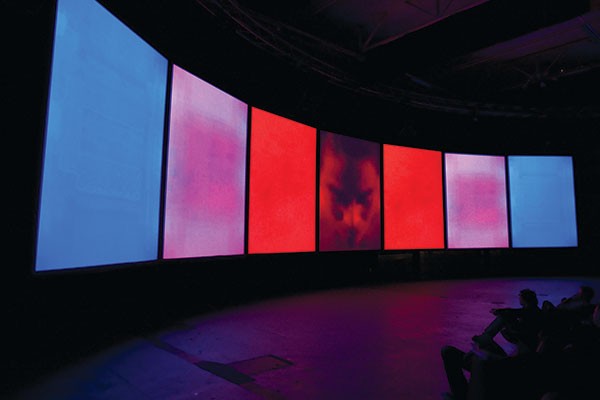At its best, art will refashion one's way of seeing. This is true of the latest exhibits by Kurt Hentschlager, an Austrian-born artist who now teaches at the School of the Art Institute of Chicago. The exhibits, at Wood Street Galleries and Space, are the U.S. premieres of three works: Hive, Model 5 and POL. From 1993 to 2003, Hentschlager teamed with Ulf Langeinrich in a group called Granular Synthesis, and the two projections at Space reflect that collaboration. (Another Hentschlager work, Zee, at 943 Liberty Ave., was closed after three gallery-goers reportedly suffered seizures.)
Hentschlager is a pioneer in the use of audiovisual media. He strives to create an experience of "being there" — to immerse the visitor in a virtual world where one's senses are overwhelmed, forcing the viewer out of his physical self. The goal, as curator Murray Horne says, is to turn the viewer from passive perceiver of the material world into active participant in a conceptual inner world. When it works, it creates a feeling of presence, when all the senses perceive the digital environment to be physically real.
Hentschlager employs animation techniques, computer-aided design and plenty of imagination. In Hive, there are two large screens set at 90 degrees to one another. The projectors have special filters to create a 3-D effect and the screens themselves are prepared with a highly reflective silver paint. With 3-D glasses, the sense of depth makes you feel you can almost touch the projected forms.
Hive reflects our collective consciousness by showing how human bodies in space can relate to each other. In this 22-minute loop, the white/orange bodies are semi-transparent and aesthetically beautiful. The choreography of the figures is mesmerizing and almost mystical. The accompanying audio, which is a low drone, creates a feeling of anxiety as bodies join together and disband, tumbling over one another, and turning into flames of light. Sometimes the bodies spin rapidly as if attracted by a black hole. It offers a vision of eternity, a scenario where they are flesh and spirit at the same time.
While Hive is a piece that you can passively absorb, the Space exhibitions are more dramatic. POL and Model 5 push the boundaries of perception. These half-hour-long pieces require patience and resist a straightforward narrative.
POL, whose initials stand for "live improvised performance" in German, starts with a noise that sounds like an approaching locomotive. Seven screens, together 45 feet wide, are filled with an electrical fuzz that fluctuates in sound and intensity. At one point the light is blinding, and at another time it resembles a speckled Jackson Pollock painting. Eventually, on each screen, a face and torso emerge from the fuzz, accompanied by the sound of heavy breathing, as if from an iron lung. For a millisecond, we see a focused image that suddenly disappears.
The next sequence contains flashing blue and black geometric designs. One feels like one has entered a wormhole in time. Sound punctuates the rapid fire of the changing screens, suddenly interfered with by static that recalls thunderous electrical storms. The projection's rhythm slows, and incorporates flashing red panels. Ultimately, a series of downward-gazing female heads appears embedded like a red/black silkscreen. Each head performs a strange pecking motion until it slowly fades out.
Model 5 is a primal scream about the intrusions of modern society. It includes four frontal heads of performance artist Akemi Takeya. Each head's movement is manipulated, and merged with eerie disembodied soundscapes. Takeya appears to be undergoing torture by electrical shock. She resembles a puppet on remote control. At one point the eyes appear to plead with the invisible controller to stop. Slowed to stop-action, the mouths emit a growl like a lion. Then the heads return to vibrating, with spontaneous exclamations from the mouth.
Hentschlager uses double exposure to represent a split personality, and sometimes to generate an erotic element. Toward the end, the heads are in a trance, muttering pieces of words. The only possible way of resisting seems to be meditation, and at the end, one senses the head is repeating a mantra.
As the writer Howard Rheingold wrote, immersive art like Hentschlager's can "alter consciousness, shape behavior and influence belief systems." In Hive, the futuristic vision of human relations on a cosmic scale might suggest that the resemblances among human beings give us more to gain by acting in concert. In POL, we observe the interface between consciousness and technology, what it means to be constrained within a body, and perhaps how technology will mold our humanity in the future; it seems a very pessimistic picture. And Model 5 deconstructs the psychology of the alter ego to suggest how modern society affects the individual.
Perhaps becoming more fully human requires more technology. In any case, Hentschlager's is a seductive art that might alter our understanding of reality.















